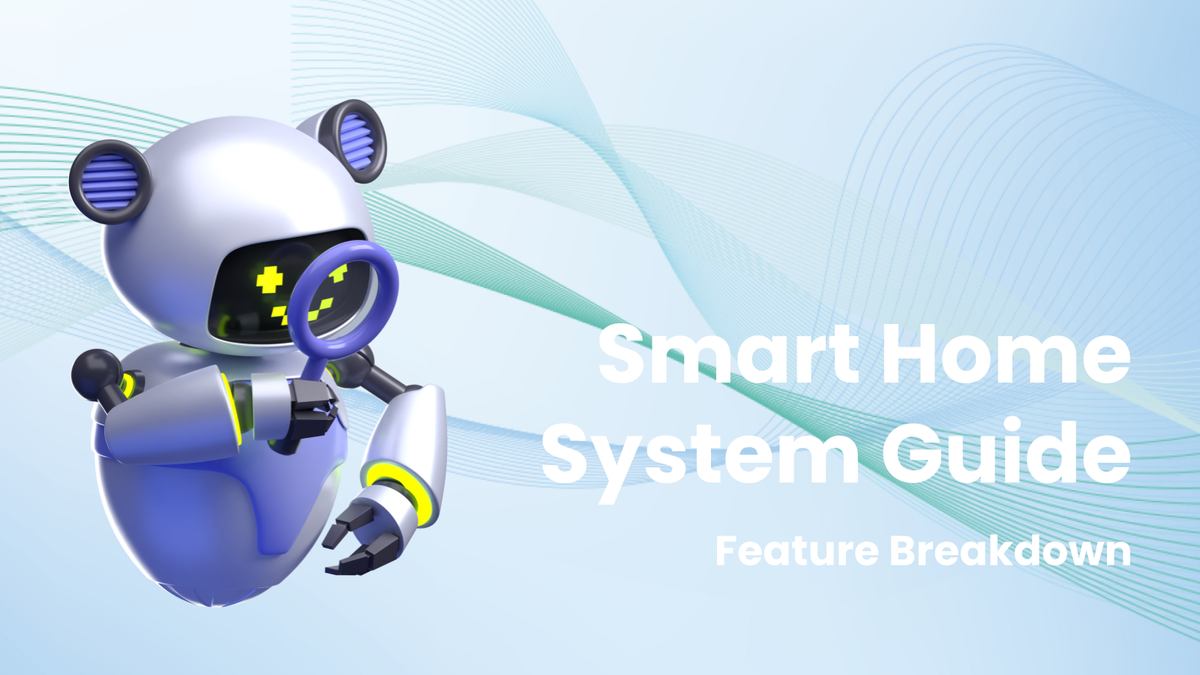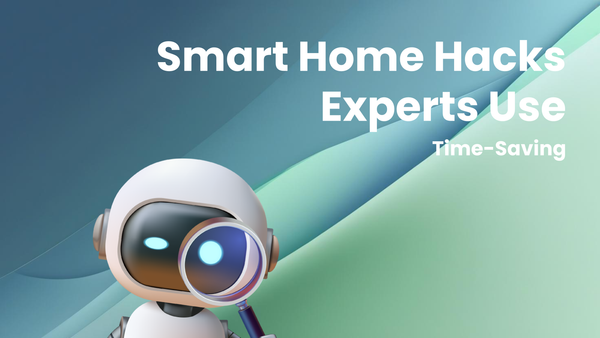Comparing Smart Home Systems: A Feature Breakdown Guide

Comparing Smart Home Systems: A Feature Breakdown Guide
Imagine waking up, and as the first rays of sun touch your window, your smart blinds automatically adjust to let in the perfect amount of light. The thermostat intelligently raises the temperature, and your coffee machine starts brewing your favorite blend, all without you lifting a finger. This isn't a scene from a futuristic movie; it's the reality of a well-integrated smart home system.
Many people jump into the smart home arena without fully understanding the nuances of different systems, leading to frustrating incompatibilities, security vulnerabilities, and ultimately, a system that falls short of its potential. This article will dissect the leading smart home systems, comparing their features, strengths, and weaknesses, empowering you to make informed decisions and create a truly intelligent and seamless living experience. We’ll explore the technology behind these systems, delve into practical applications, and equip you with actionable advice to build the smart home of your dreams.
Understanding the Smart Home Ecosystem
The smart home isn't just about individual gadgets; it’s about creating a cohesive ecosystem where devices communicate and work together to automate tasks and enhance your living experience. At its core, a smart home system comprises interconnected devices, a central hub or platform, and a user interface that allows you to control and monitor everything.
What Makes a Home "Smart"?
Smart home devices offer remote control, automation, and data-driven insights. This can range from simple features like controlling lights with your voice to complex scenarios like automatically adjusting energy consumption based on real-time pricing. Smart devices connect to your home network, typically via Wi-Fi, Zigbee, Z-Wave, or Bluetooth. This connectivity allows them to be controlled remotely through smartphone apps, voice assistants, or even pre-programmed schedules.
The Role of the Central Hub
The central hub acts as the brain of your smart home, facilitating communication between devices that use different protocols. Think of it as a universal translator, ensuring that your Zigbee-based smart bulbs can talk to your Wi-Fi-enabled thermostat. Some systems, like those centered around voice assistants like Amazon Alexa or Google Assistant, can function without a dedicated hub, utilizing the assistant itself as the central control point. Others, especially those focusing on security or comprehensive home automation, often rely on a dedicated hub for enhanced reliability and control.
Why a Smart Home Matters
Beyond the novelty factor, a well-designed smart home provides tangible benefits:
- Increased Energy Efficiency: Smart thermostats, lighting controls, and appliance monitoring can significantly reduce energy consumption, lowering utility bills and minimizing your environmental footprint.
- Enhanced Security: Smart locks, security cameras, and alarm systems provide layers of protection, allowing you to monitor your home remotely and receive alerts in case of intrusion.
- Improved Convenience: Automate daily tasks like turning on lights, adjusting the temperature, or watering the lawn, freeing up your time and energy.
- Accessibility: Smart home technology can empower individuals with disabilities or limited mobility to live more independently and comfortably.
A Brief History of Home Automation
The concept of home automation dates back to the early 20th century with the invention of appliances like electric washing machines and refrigerators. However, the true genesis of the modern smart home emerged in the 1970s with the introduction of X10, a communication protocol that allowed devices to communicate over existing electrical wiring. While limited in its capabilities, X10 paved the way for more sophisticated systems. The late 1990s and early 2000s saw the rise of dedicated home automation systems, often requiring professional installation and carrying a hefty price tag. Today, advancements in wireless technology, cloud computing, and voice assistants have made smart home technology more accessible and affordable than ever before.
Deep Dive: Feature Breakdown of Leading Smart Home Systems
The smart home landscape is crowded with options, each offering a unique blend of features and capabilities. This section provides a detailed comparison of some of the leading systems:
1. Amazon Alexa Ecosystem
- Strengths:
- Voice Control: Alexa's natural language processing is among the best, making voice control intuitive and seamless.
- Device Compatibility: Alexa boasts an enormous ecosystem of compatible devices, ranging from light bulbs and thermostats to TVs and appliances.
- Ease of Use: Setting up and managing Alexa devices is generally straightforward, thanks to the intuitive Alexa app.
- Routines: Alexa Routines allow you to trigger multiple actions with a single voice command or based on a specific time or event.
- Weaknesses:
- Privacy Concerns: Alexa devices constantly listen for the wake word, raising concerns about privacy and data collection.
- Reliance on Internet Connection: Alexa requires a stable internet connection to function, which can be problematic during outages.
- Limited Local Control: Most Alexa-controlled devices rely on cloud processing, meaning they may not work if the internet is down.
- Examples:
- "Alexa, good morning" could trigger a Routine that turns on the lights, starts playing your favorite news podcast, and tells you the weather forecast.
- Using an Alexa-enabled smart lock, you can remotely unlock the door for a delivery person and then relock it once they've left.
- Protocols Supported: Wi-Fi, Bluetooth, Zigbee (on some Echo devices).
- Typical User: Tech-savvy individuals and families seeking a voice-controlled smart home with a wide range of compatible devices.
2. Google Assistant Ecosystem
- Strengths:
- Natural Language Processing: Google Assistant's language understanding is highly advanced, allowing for nuanced voice commands.
- Integration with Google Services: Seamless integration with Google Calendar, Gmail, Maps, and other Google services.
- Proactive Assistance: Google Assistant can proactively offer information and suggestions based on your habits and preferences.
- Device Compatibility: A vast ecosystem of compatible devices, similar to Alexa.
- Weaknesses:
- Privacy Concerns: Similar to Alexa, Google Assistant raises privacy concerns due to its constant listening and data collection.
- Reliance on Internet Connection: Requires a stable internet connection to function.
- Complexity: Setting up complex routines can be more challenging compared to Alexa.
- Examples:
- "Hey Google, what's my commute like?" will provide real-time traffic updates and estimated travel time to work.
- Google Assistant can automatically adjust the thermostat based on your location using geofencing.
- Protocols Supported: Wi-Fi, Bluetooth, Thread (on some Nest devices).
- Typical User: Individuals deeply embedded in the Google ecosystem who value proactive assistance and advanced natural language processing.
3. Apple HomeKit
- Strengths:
- Security and Privacy: Apple prioritizes security and privacy, implementing robust encryption and data protection measures.
- Seamless Integration with Apple Devices: HomeKit seamlessly integrates with iPhones, iPads, Apple Watches, and Macs.
- Siri Voice Control: Control your smart home devices using Siri voice commands.
- HomeKit Secure Video: Securely store video recordings from your security cameras in iCloud.
- Weaknesses:
- Limited Device Compatibility: Smaller ecosystem of compatible devices compared to Alexa and Google Assistant.
- Higher Cost: HomeKit-compatible devices tend to be more expensive.
- Requires Apple Hub: Requires an Apple TV, HomePod, or iPad to act as a home hub for remote access and automation.
- Examples:
- Using the Home app, you can create scenes that adjust lighting, temperature, and music with a single tap.
- Siri can automatically lock your doors and turn off the lights when you leave home.
- Protocols Supported: Wi-Fi, Bluetooth, Thread.
- Typical User: Apple enthusiasts who prioritize security, privacy, and seamless integration with their Apple devices.
4. Samsung SmartThings
- Strengths:
- Wide Protocol Support: Supports a wide range of protocols, including Wi-Fi, Zigbee, Z-Wave, and Bluetooth, ensuring compatibility with a diverse range of devices.
- Hub-Based System: A dedicated hub provides local control and enhanced reliability.
- Customizable Automation: Offers advanced automation capabilities through SmartThings Routines and the Groovy scripting language (though Groovy support is being phased out in favor of Lua).
- Integration with Samsung Appliances: Seamless integration with Samsung smart appliances.
- Weaknesses:
- Complexity: Can be more complex to set up and configure compared to simpler systems like Alexa and Google Assistant.
- Reliability Issues: SmartThings has historically been plagued by reliability issues, although Samsung has made strides in improving performance.
- Transition from Groovy: The transition away from the Groovy scripting language for custom automation has caused frustration among some users.
- Examples:
- SmartThings can automatically lock your doors, turn off the lights, and arm your security system when you go to bed.
- Using motion sensors, SmartThings can trigger lights to turn on when you enter a room.
- Protocols Supported: Wi-Fi, Zigbee, Z-Wave, Bluetooth.
- Typical User: Users who want a robust and customizable smart home system with support for a wide range of devices and protocols.
5. Hubitat Elevation
- Strengths:
- Local Control: Operates entirely locally, without relying on the cloud, ensuring privacy and reliability.
- Advanced Automation: Offers powerful automation capabilities through its Rules Machine and custom apps.
- Device Compatibility: Supports a wide range of Zigbee and Z-Wave devices.
- Privacy Focused: No data is sent to the cloud, providing maximum privacy.
- Weaknesses:
- Steep Learning Curve: Requires technical expertise to set up and configure.
- Limited Voice Control Integration: Voice control integration is not as seamless as with Alexa or Google Assistant and often requires third-party integrations.
- User Interface: The user interface is not as polished as some of the other systems.
- Examples:
- Hubitat can create complex automations based on multiple conditions and events, such as automatically adjusting the thermostat based on occupancy, time of day, and weather conditions.
- Using custom apps, you can integrate Hubitat with other systems and services.
- Protocols Supported: Zigbee, Z-Wave.
- Typical User: Tech-savvy users who prioritize local control, privacy, and advanced automation capabilities.
Common Pitfalls and How to Avoid Them
Embarking on the smart home journey can be exciting, but it's essential to be aware of potential pitfalls and take steps to avoid them:
- Lack of Planning: Don't just buy gadgets without a clear plan. Define your goals and prioritize the features that are most important to you. Consider the overall architecture of your smart home and how different devices will interact.
- Solution: Create a detailed plan that outlines your smart home goals, desired features, and budget. Research different systems and devices to ensure compatibility and functionality.
- Incompatibility Issues: Not all smart home devices work with all systems. Before purchasing any device, carefully check its compatibility with your chosen platform.
- Solution: Consult device compatibility lists and user reviews to ensure that your chosen devices will work seamlessly with your smart home system.
- Security Vulnerabilities: Smart home devices can be vulnerable to hacking if not properly secured. Use strong passwords, enable two-factor authentication, and keep your devices updated with the latest security patches.
- Solution: Implement strong security practices, such as using strong passwords, enabling two-factor authentication, and regularly updating your devices' firmware. Consider using a separate Wi-Fi network for your smart home devices.
- Over-Reliance on the Cloud: Cloud-based systems are convenient, but they can be unreliable during internet outages. Choose systems that offer local control as a backup.
- Solution: Opt for smart home systems that offer local control capabilities, allowing your devices to function even when the internet is down.
- Ignoring User Experience: A smart home should be easy to use and intuitive. Avoid systems that are overly complex or require constant troubleshooting.
- Solution: Prioritize user-friendly systems with intuitive interfaces and easy-to-understand instructions. Consider the user experience for all members of your household.
- Forgetting About Scalability: Your smart home needs may evolve over time. Choose a system that can easily accommodate new devices and features as your needs change.
- Solution: Select a smart home system that is scalable and can easily accommodate new devices and features as your needs evolve.
- Neglecting Network Infrastructure: A weak Wi-Fi network can cripple your smart home. Ensure that you have a robust and reliable network infrastructure to support all your connected devices.
- Solution: Invest in a high-quality router and consider using a mesh Wi-Fi system to ensure adequate coverage throughout your home.
Building Your Smart Home: A Step-by-Step Guide
Ready to create your own smart home? Here's a step-by-step guide to get you started:
- Define Your Goals: What do you want to achieve with your smart home? Increased security? Energy savings? Convenience? Prioritize your needs and wants.
- Choose a Smart Home System: Based on your goals and preferences, select a smart home system that meets your needs. Consider factors such as device compatibility, security, privacy, ease of use, and cost.
- Start Small: Don't try to automate everything at once. Begin with a few key devices, such as smart lights, a smart thermostat, or a smart security camera.
- Set Up Your Hub (If Applicable): Follow the manufacturer's instructions to set up your smart home hub. Connect it to your network and create an account.
- Connect Your Devices: Add your smart devices to your chosen system. Follow the manufacturer's instructions to pair each device with your hub or voice assistant.
- Create Automations: Use the automation features of your chosen system to create routines and schedules that automate tasks. For example, you could create a routine that turns on the lights when you enter a room or automatically adjusts the thermostat based on the time of day.
- Test and Refine: Test your automations and make adjustments as needed. Pay attention to how your smart home is working and make changes to optimize its performance.
- Expand Gradually: As you become more comfortable with your smart home system, gradually add new devices and features.
- Stay Updated: Keep your devices and software updated with the latest security patches and firmware updates.
- Monitor and Adjust: Regularly monitor your smart home to ensure that it is working as intended. Make adjustments as needed to optimize its performance and meet your evolving needs.
The Future of Smart Homes
The smart home is constantly evolving, with new technologies and trends emerging all the time. Here are a few things to watch for in the future:
- More Advanced AI: Artificial intelligence will play an increasingly important role in smart homes, enabling devices to learn your habits and preferences and proactively anticipate your needs.
- Greater Interoperability: Efforts are underway to create more standardized protocols and platforms, making it easier for devices from different manufacturers to work together seamlessly. Matter, a new connectivity standard, aims to address this challenge.
- Edge Computing: More processing will be done locally on smart home devices, reducing reliance on the cloud and improving privacy and responsiveness.
- Personalized Experiences: Smart homes will become increasingly personalized, tailoring to the individual needs and preferences of each user.
- Health and Wellness Applications: Smart homes will play a greater role in promoting health and wellness, with devices that monitor vital signs, track sleep patterns, and provide personalized recommendations.
Conclusion: Embrace the Smart Home Revolution
The smart home revolution is here, offering unprecedented opportunities to enhance your living experience, improve energy efficiency, and increase security. By understanding the different systems available, avoiding common pitfalls, and following a step-by-step approach, you can create a smart home that is tailored to your specific needs and preferences.
Remember that the best smart home is not just about technology; it's about creating a comfortable, convenient, and secure environment that enhances your quality of life. Don't be afraid to experiment, learn, and adapt as you build your smart home.
Now that you have a deeper understanding of smart home systems, take the next step: identify one area in your home where you'd like to improve automation or security. Research compatible devices and begin experimenting. Your journey to a smarter, more connected home starts now.




